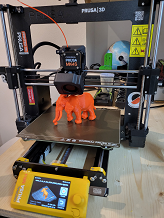
- Details
deep space computing AG has experience with cryptocurrencies and blockchain technology beginning from 2013. Through the years deep space employees collected experiences in Blockchain resumed in the table below:
| Period | Experience |
| 2013-Feb 2014 | Running self written speculative bots in Python on MtGox |
| Feb 2014 | Crash of crypto exchange MtGox |
| July, 7 2017 | First Gridcoin mined |
| July 2017 - ongoing | Creating a Computational Cluster to mine Gridcoins |
| Sep 2017-Dec 2018 | Running self written arbitrage bots in PHP for trading pairs Solarcoin/Bitcoin and Gridcoin/Bitcoin. The bots are able to self balance by offsetting trade probabilites. |
| July 2017 - ongoing | Running 2 Bitcoin wallets, 3 Gridcoin wallets (1 research, 1 investment, 1 testnet), 1 Solarcoin wallet, 1 Ethereum wallet, 1 IOTA wallet, 1 Biblepay wallet, 1 Lightning Node |
| 2018 | Contributions to the Gridcoin Whitepaper |
| January 2019 | Adding an entropy source with semiconductor junction to the cluster |
| February 2019 | Adding an entropy source with ionospheric radio noise to the cluster |
| March 2019 | New Lightning Node on the Bitcoin Network |
| October 2019 | Cluster reaches a peak performances of 97 Teraflops with 8 kW consumption |
| March 2021 | Computational Cluster transferred from Miralago to San Carlo |
| January 2022 | Experimenting with Crypto Stamp, the new Non Fungible Token of Swiss Postal Services (NFT) |
| August 2024 | Successfull recovery of MtGox funds |
| November 2024 | Computational Cluster upgraded to Ampère architecture to meet demand for AI workloads |
A good introductory book to understand Bitcoin and the underlying Blockchain technology is "Bitcoin, Blockchain und Kryptoassets" by Aleksander Berentsen and Fabian Schär.

- Details
deep space computing employees developed over the years the worldwide first framework for distributed computing over a peer to peer network, called Global Processing Unit. More details and screenshots are available on the project site.
The screenshot below shows the main GPU client while performing three computations in parallel.

There is also a 3D frontend to show how many nodes are connected with each other. Lines between nodes are connections among computers and their color represent how much TCP traffic goes through the nodes.

The GPU client is presented in the paper below. Click on the image below to open it.
- Details

Analyzing a proprietary block cipher at Omnisec AG
In 2003, Tiziano worked at Omnisec AG and analyzed the proprietary block cipher and hash function of Omnisec. He performed several black box and white box analysis. The documents and the software created by him are confidential and kept in a safe.
Omnisec Work Attestation (PDF)

- Details

If you want to start programming an adiabatic quantum computer, we suggest you to visit DWave Leap. You will get one minute of computational time on the Dwave Quantum Computer for free and there are plenty of tutorials and documentation to play with.
Below you find our recommended reading to get into the world of classical quantum computing. Reading it through was like climbing a mountain: it was very interesting because advanced topics of Cryptography, Theoretical Informatics and Mathematics, including Tensor Calculus converge in this book. Additionally, current implementations of Quantum Computers are inspected and there is also a readable chapter about the History of Quantum Mechanics at the end. The best way to use it is to read it through carefully doing all exercises.
Just click on the image to order the book on Amazon.
- Details
deltasql - Database Evolution under Control
deep space computing developed the initial releases of deltasql in 2007. It is a client server/software to manage incremental SQL scripts on several database schemas, both in production and development. By using deltasql it is possible to version database schemas in a similar manner as source code is versioned with git or similar tool. The software still enhanced is used through the entire world and had so far 14'100 downloads on sourceforge.net. deltasql is Open Source and released under the GPL license. Click here to visit the project website.
MongoDB
When the burden of data is so big that is not manageable anymore by traditional relational dabatases, No-SQL databases like MongoDB come to help. A good introductory book on MongoDB which explains everything from the basics down to advanced techniques like sharding is "The Definitive Guide to MongoDB":
Page 2 of 3











